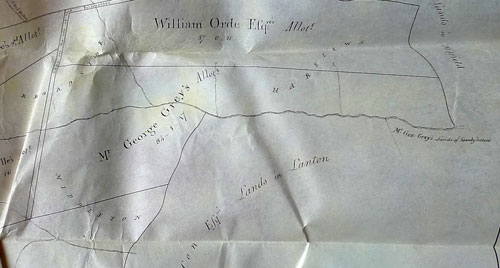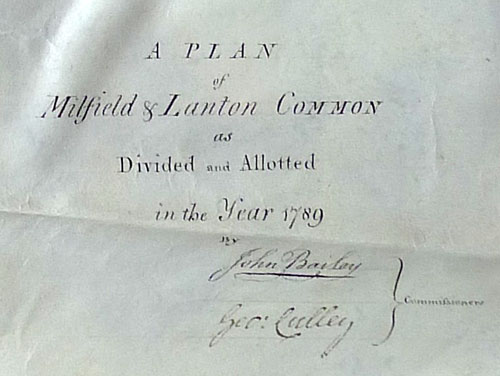
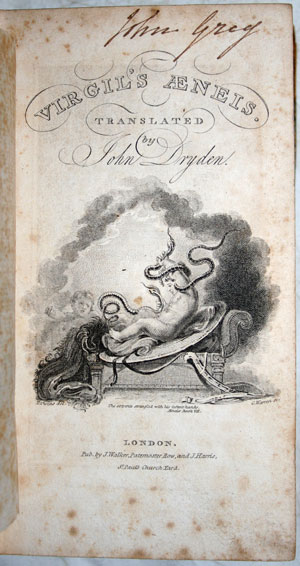
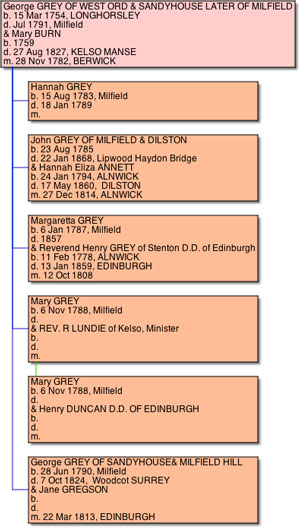


Josephine Butler in her memoir of her father John wrote:
"When my grandfather first came to Milfield the plain was still a forest of wild broom. He took his axe, and like a backwood settler cut away the broom, and cleared for himself a space on which to begin his farming operations."
Josephine also records that:
"His (George's) daughter remembers to have seen him lifted into a carriage, wherein he reclined among pillows, looking very ill; and I have been told that grandmamma's sorrow for his death was such that she never suffered his name to be mentioned in her presence. She was a woman worthy to be remembered. She was very thoughtful and studious. She read a great deal with her children, and also alone. Her practical energy, which was great, was called out in the care, now devolving entirely on her, of her farm, work-people, and stock. She attended to everything herself, and while engaged in active household work, she would challenge her children to trials of memory by recitations from Pope's Homer. Her acquaintance with literature made her an authority with the promoters of the Wooler library, to whom she supplied lists of books. She was slender and graceful in figure, quick and active in all her movements, an excellent rider, and much admired on horseback. She had rich chestnut hair, and a kind face, full of bright intelligence. "


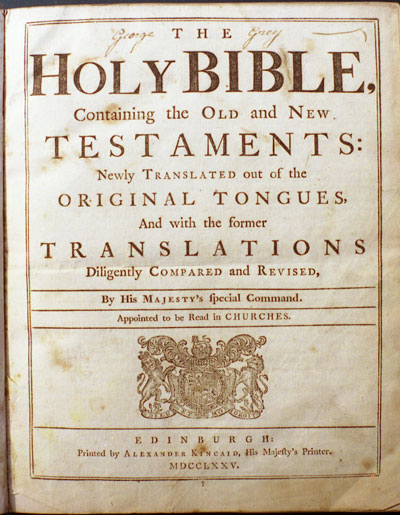

Mary Burn, born 1759, died 27 August 1827 at Kelso Manse aged 68. Mary Burn married George Grey of West Ord and Sandyhouse and later of Milfield on 28 November 1782 . She had five children, the oldest of which Hannah died at the age of six.
Her husband George died in July 1791, at the early age of 38, leaving her a widow with two sons and two daughters, the eldest being John , who was then about six years old. She farmed Milfield until John was old enough to take up the work.
George Grey of Sandyhouse and West Orde born 1749
Mary Burn of Berwick married at Milfield at Whitsontide 1782
Hannah Grey Born August 15 1783 Milfield
d. 1791
John Grey Born August 23 1785 Milfield
m 27 Dec 1814 Hannah Eliza Annett d.1860 at Corbridge
John Grey d. Lipwood 1868 b. Corbridge
Margaretta Grey Born January 6 1787 at Milfield
m. Revd. Henry Grey of Stenton afterwards of Edinburgh
Mary Grey Born November 6 1788 at Milfield
m. Dr Lundi of Kelso 2nd Revd Duncan
George Grey Born June 28th 1790 at Milfield
died at Woodcot Oct 1824 from broken leg
George Grey of Sandyhouse and West Orde died at
the “Old House” in Milfield 1793* aged 44 yrs
Mary Burn died Kelso Manse 1827 aged 68 yrs
* In the History of Northumberland's pedigree George Grey's death is said to be 1791 and the Kirknewton registers give his age as 38. The family bible says he died in 1793, aged 44 which must be incorrect since his will was proved in 1791. If the date on the grave is correct he was born in about 1753. The bible says he was born in 1749. The pedigree says he was baptised at Longhorsley on 15 March 1754. There were two George's born to John Grey at Longhorsley: 13 July 1749 and 15 March 1754. George the first son "died Janr 7th 17[52] aged 3 years" according to his grave there.

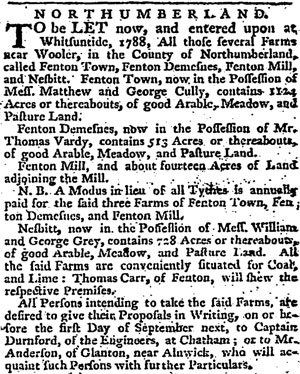
NORTHUMBERLAND TO be LET now, and entered upon at Whitsuntide, 1788, All those several Farms near Wooler, in the County of Northumberland called Fenton Town, Fenton Demesnes, Fenton Mill, and Nesbitt. Fenton Town, now, in the Possession of Mess. Matthew and George Cully, contains - 1124 Acres or thereabouts, of good Arable, Meadow, and Pasture Land. Fenton Demesnes, now in the Possession of Mr. Thomas Vardy, contains 513 Acres or thereabouts of good Arable, Meadow, and Pasture Land. Fenton Mill, and about fourteen Acres of Land adjoining the Mill. N.B. A Modus in lieu of all Tythes is annually paid for the said three Farms of Fenton Town, Fenton Demesnes, and Fenton Mill. Nesbitt, now in the Possession of Mess. William and George Grey, contains 728 Acres or thereabouts of good Arable, Meadow, and Pasture land. All the said Farms are conveniently situated for Coal, and Lime: Thomas Carr, of Fenton, will shew the respective Premises. All Persons intending to take the said Farms, are desired to give their Proposals in Writing, on or before the first Day, of September next, to Captain Durnford, of the Engineers, at Chatham; or to Mr. Anderson, of Glanton, near Alnwick, who will acquaint such Persons with further Particulars
The Public Advertiser, 19 August 1786, Page 4
Sacred to the memory of George Grey Esqr of Sandyhouse who died at Milfield 1st July 1791 aged 38 years
Hannah his daughter died 18th January 1789 aged 5 years and 6 months
Mary his wife died at Kelso 27th August 1827 aged 68 years."
Kirknewton Monumental inscription.
Churchyard Section E Row 6 - 14
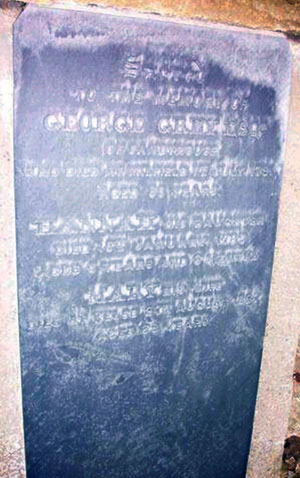
Sandy House was called Sandy Lodge on older maps.
Photographed in 2006 by Claire Grey
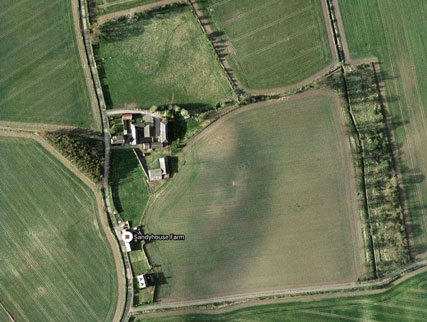
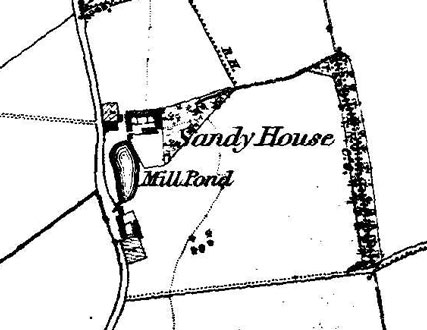
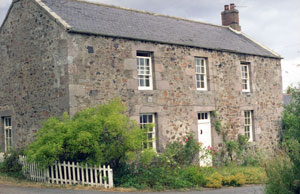
John Grey of Dilston and his sisters were born at Milfield but not at Milfield Hill because it hadn’t been finished. They were born in "The Old House". This is also where his father George Grey died according to the family bible: George Grey of Sandyhouse and West Orde died at the “Old House” in Milfield.
John Grey of Dilston quoted on page 10 of his daughter Josephine Butler’s memoir: “I had a sister called Hannah, who died young. She was older than myself. One of my earliest recollections is of her leading me by the hand on a windy day from the old house at Milfield to a cottage in the village”
From Memoir of John Grey page 10 quote from Mrs Lundie Duncan (his sister): “The house at Milfield, where we were all born, may now be a ruin. It stood at the open end of the village, and had large stone pillars at the corners of the garden fence. The coach passed daily from London to Edinburgh, and vice versa” and
“We had removed to the house on the hill, and John had become master.”
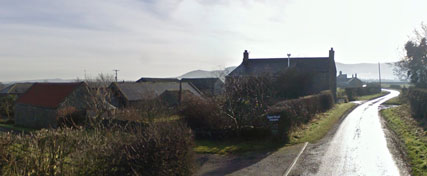
The history of the land is given in the Lanton section of the Northumberland County Histories Vol XI on page 141.
LANTON TOWNSHIP John Collingwvood was part owner of the vill in 1580, and in 1584 he held the tower. In 1630 the estate called Sandyhouse in the north east corner of the township belonged to Henry Collingwood of Etal. In that year the latter conveyed two farmholds of the yearly rent of £3 11s. and other lands of the yearly value of 9s, all in Lanton, to Luke Collingwood of Lanton, who appears among Northumberland freeholders in 1638 and in 1663 was returned as part owner of the township with a rent roll of £40, which was not very much smaller than that of the Strothers. He died in 1708 and his grandson and heir, also named Luke, conveyed the property to William Moore of Berwick, who in turn conveyed it three years later to William Forster, whose grand-daughter married Fenwick Stow, when the estate was settled and afterwards vested in their son, William Stow. The latter's heirs sold it in 1787 for £2,600 to George Grey of West Ord, who in 1791 was allotted 84 acres in respect of Sandyhouse, when Lanton common was enclosed, and further acquired from Alexander Davison 57 acres of his Lanton estate and the tithes of corn, wool and lamb of Sandyhouse, in exchange for part of his property. He died that same year leaving his 'capital messuage in Langton' and his 'lands in Sandyhouse' to his second son George, who died intestate in 1824, when his property passed to his elder brother John, from whom in 1825 Sir William Davison bought Sandyhouse, containing 285 acres, for £13,500.'' Henceforth Sandyhouse was an integral part of the estate of Lanton and passed with it to the Lambtons.
